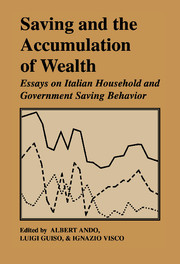Book contents
- Frontmatter
- Contents
- Foreword by Antonio Fazio
- List of contributors
- List of figures
- List of tables
- Acknowledgments
- Introduction
- I Saving trends, government deficit and demographic changes
- II Life-cycle saving and precautionary motives
- 5 Young households' saving and the life cycle of opportunities. Evidence from Japan and Italy
- 6 Dissaving by the elderly, transfer motives and liquidity constraints
- 7 Earnings uncertainty and precautionary saving
- 8 Risk sharing and precautionary saving
- III Borrowing constraints, intergenerational transfers and bequests
- Appendixes
- Index
6 - Dissaving by the elderly, transfer motives and liquidity constraints
Published online by Cambridge University Press: 05 May 2010
- Frontmatter
- Contents
- Foreword by Antonio Fazio
- List of contributors
- List of figures
- List of tables
- Acknowledgments
- Introduction
- I Saving trends, government deficit and demographic changes
- II Life-cycle saving and precautionary motives
- 5 Young households' saving and the life cycle of opportunities. Evidence from Japan and Italy
- 6 Dissaving by the elderly, transfer motives and liquidity constraints
- 7 Earnings uncertainty and precautionary saving
- 8 Risk sharing and precautionary saving
- III Borrowing constraints, intergenerational transfers and bequests
- Appendixes
- Index
Summary
Introduction
The stripped–down version of the life–cycle model implies that older consumers should start decumulating assets right after retirement at a rate sufficient to achieve zero wealth by the time of death. Of course, this extreme pattern of behavior only obtains under highly restrictive assumptions, such as lack of uncertainty about the time of death, the absence of health uncertainty and the absence of a bequest motive. Relaxing these assumptions might still lead to decumulation of assets as households get older, though at a slower rate.
Several studies, for various countries, provide evidence on this issue. By and large, there does appear to be asset decumulation by the elderly though at a much lower rate than would be implied by a life–cycle model without uncertainty or bequests. Thus, as is pointed out by Ando and Kennickell (1987), the traditional characterization of the no–uncertainty–no–bequests life–cycle model is clearly rejected by the data. While there is a fair consensus on this statement, there is much less agreement on the reason for the observed slowness of decumulation. As already mentioned, two main explanations have been proposed: the precautionary saving induced by (uninsurable) uncertainty about the time of death or by the possibility of major catastrophes in old age that require large outlays; and the desire to pass part of the accumulated assets on to one's heirs.
Information
- Type
- Chapter
- Information
- Saving and the Accumulation of WealthEssays on Italian Household and Government Saving Behavior, pp. 188 - 213Publisher: Cambridge University PressPrint publication year: 1994
Accessibility standard: Unknown
Why this information is here
This section outlines the accessibility features of this content - including support for screen readers, full keyboard navigation and high-contrast display options. This may not be relevant for you.Accessibility Information
- 1
- Cited by
